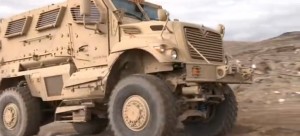Images from Ferguson of camo-clad snipers, armored trucks and suburban cops equipped with the accouterments of war ignited a debate about the militarization of local law enforcement.
To assuage a concerned public, police agencies throughout the nation have returned military gear obtained through a federal surplus program. The San Jose Police Department relinquished a 15-ton mine-resistant vehicle, despite protests from the rank and file.
But a SWAT team’s response to the San Bernardino shootings earlier this month has again shifted the conversation. Officers responded like a small army, rolling up to the scene in fleets of Bearcats. Immediately, police and pundits pointed to the massacre as an example of why domestic cops need military tools and tactics.
James Gonzales, vice president of the San Jose Police Officers’ Association, says the attacks in Southern California and Paris should prompt the city to reconsider its stance on combat vehicles.
“It’s time for a re-examination of the use of militarized vehicles by law enforcement agencies,” he wrote in an op-ed for the Mercury News, “and the costs of putting political correctness above public safety.”
Concerns about police militarization should focus on de-escalation tactics, training, oversight and community engagement, he wrote. Instead of giving up its mine-resistant truck, the San Jose Police Department should have justified the need for it, he added.
“Explaining what an armored vehicle is and why it is necessary to protect the public and police in an emergency is important,” he said. “San Jose shouldn’t reject this life saving apparatus because those in charge are unwilling to do the hard work of engaging the community.”
Gonzales pointed to the controversy about the SJPD drone as an example. While the city took some heat for acquiring the remote-controlled flying camera, it quelled fears of police surveillance by working with residents to craft a policy limiting its use to the bomb squad. In an age of mass shootings, he argued, police need military-grade weaponry.
It should be noted, however, that the call for de-militarizing police stemmed from a perceived misuse of combat gear. Backlash came after cops in Ferguson, Missouri, deployed the same equipment against civilians protesting the police shooting of Michael Brown.
Just before the events in Ferguson, the American Civil Liberties Union (ACLU) released a report titled, “War Comes Home: The Excessive Militarization of American Policing.” Of the 800 paramilitary raids examined by the ACLU in the course of its yearlong investigation, 80 percent were for routine police work such as executing search warrants at people’s homes.
The dialogue about de-militarization also highlighted a lack of transparency around officer-involved shootings. According to a Washington Post database, police have shot and killed more than 940 people so far this year. That’s double the number recorded any previous year by federal officials.
In his op-ed, Gonzales wrote that police play the role of both “guardian and warrior.”
Sue Rahr, a retired sheriff and member of President Obama’s Task Force on 21st Century Policing, urged police to consider themselves foremost as guardians. Being trained and equipped for war could feed into the warrior mentality, she wrote, unless those resources are coupled with proper training and public oversight.


